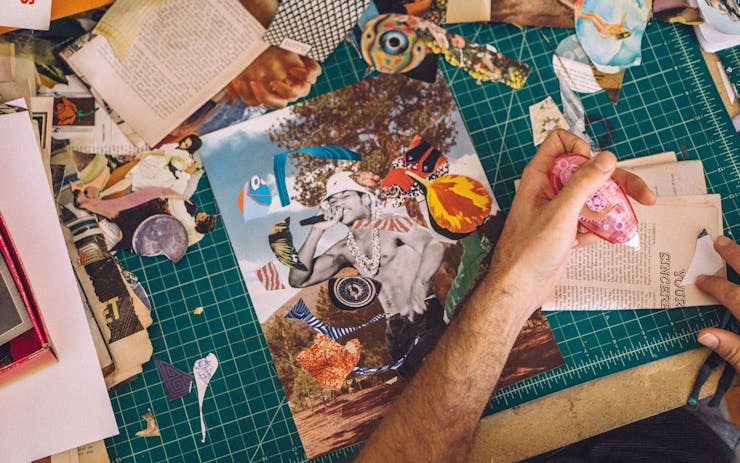It was back in high school when I first heard it on “America’s Most Blunted.” A new rule that would inspire a post-D.A.R.E. lifestyle for my work ethic: “Creativity. It’s a known fact that grass increases creativity from eight to eleven times. In fact, everyone finds that they’re more creative stoned than straight.”
Need a burst of creativity? Find cannabis near you.
MF DOOM and Madlib’s seminal Hip-Hop record, Madvillainy, introduced a slew of ideas about cannabis that I hadn’t heard in my pre-teen years. The sample of Ron Jacobs’ A Child’s Garden Of Grass (A Pre-Legalization Comedy) was a clever way to address the herb as an important part of the creation process, as well as introduce it to an audience of young Hip-Hop listeners. It was a bizarre sample for a hazy song and album, but it fit, it educated.
It taught a generation of teenagers that weed wasn’t as harmful as we were led to believe. In actuality, it induced creativity. And if smoking weed created an odd, forward-thinking product like Madvillainy, perhaps it wasn’t such a bad habit to take up after all.
Cannabis, Creativity, and Artistic Hustle

Imaginative and uniquely himself, Saunders is living proof of how well weed can intertwine with the visual arts.
Born in Boynton Beach, South Florida and now residing in LA, Dewey Bryan Saunders is a true jack-of-all-trades within the spectrum of art. His interest in the arts sparked when he was a child, where he spent his free time redrawing comics from his collection and his favorite cartoon characters. He inched toward photography in high school, and eventually went on to earn a degree in graphic design at Tyler Junior College. His path would then take him into editorial work for The New Yorker magazine and working on minor advertising campaigns.
Harnessing a controlled form of chaos in his own tiny world, Saunders is best known for his psychedlic collages, crafting vivid, dusty scenes from older publications and repurposing them for his own faux, often surreal memories. He’s worked with Stones Throw Records, The Fader, Ray-Ban, and created artwork for musicians like Anderson .Paak, Chronixx and Lil Uzi Vert.
Saunders’ breakthrough came with his work alongside Anderson .Paak, leading up to the musician’s second album, Malibu. Saunders was found by .Paak through Instagram, after the illustrator released a slew of hip hop portraits onto the platform and tagged rappers in his posts. The method was useful for Saunders to get noticed, and with rappers and peers gawking over his gorgeous portraits and unique style, he was set. This method proved to be a key part in his success.
Impressing Musical Artists With Surreal Style

(Courtesy of Joshua Lang)
Once .Paak reached out to Saunders to work on Malibu, the two would go on to create what would become the permanent visual component to Anderson .Paak’s music. Under creative director Cory Gomberg, Saunders crafted a style of surreal, absurdist atmospheres for .Paak to play within. The musician’s singles, cover art, and Instagram feed became an outlet for Saunders’ cool, vintage expression of mixed media. Likewise, .Paak felt synonymous with cool.
“Having my perception shifted a bit allows me to view work in a different light.”
“I was really inspired by guys like Cody Hudson, Wes Lang, Mike Perry, Ed Ruscha, and Hockney,” Saunders says of his work. “Over time, my commercial work and personal work became mostly made with the collage method, but I still draw and paint. I think as a graphic designer, each project dictates which media is used. I like to switch it up. I illustrated the new Vacationer album cover “Mindset” which was a nice change of pace.”

(Courtesy of Joshua Lang)
As for his work method, cannabis is laced throughout. “I find it extremely beneficial in a creative aspect and in a self-care medicinal aspect,” he says. “Creatively, it allows me to see things from a different perspective and loosens me up, makes me more open-minded, and open to new concepts and ideas. I find it very useful for brainstorming, ideation, image sourcing and making mood boards. It really will help with composition and colors too, generally image creation is more fluid and easier.”
For Saunders, high-energy strains are a favorite, “my preference for studio work— the hazes, diesels, Sour Tangie—help me stay engaged and excited.”
Find Sour Tangie Nearby
Today, Dewey Saunders still dabbles in photography, ink sketching, and illustration. His Instagram feed shows his constant progression into his distinct style. Saunders’ lacing of 60’s psychedelia with cool blues and warm summer tones makes up his vivid world. And for those willing, he extends a hand toward musicians, brands, and fellow artists who want a place in his maddening realm of mixed media.
Imaginative and uniquely himself, Saunders is living proof of how well weed can intertwine with the visual arts.
“I don’t smoke for technical aspects of the execution and production,” he tells Leafly on mixing weed with work. “I prefer to knock out the nitty-gritty designing work clear-headed so that there are no mistakes. After the heavy lifting is finished, a little herb is beneficial for review and critique. Having my perception shifted a bit allows me to view work in a different light.”Feeling an artistic spark?





